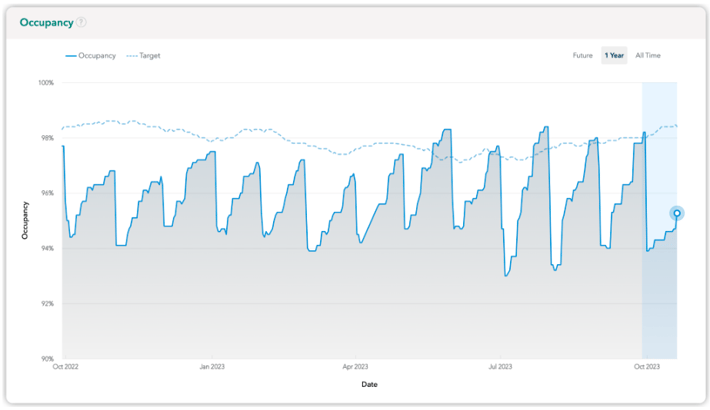Are you looking for ways to make your apartment community more efficient and effective? This is Part 4 of our Apartment Vacancy Analysis series, which will help you find and fix the gaps across the marketing and leasing chain, and offers practical strategies and tools to help take your apartment community to the next level! Access the full table of contents available below.
🤕 Problems & symptoms causing more vacancies then necessary
"We lease well, but always seem to have vacancy we can't get rid of."
So much of an apartment community's operation hinges on attracting prospective residents and nurturing those leads to sign a lease. 'Our job's done!' is a typical attitude once someone signs a lease.
But this stage in your marketing and leasing chain can be one of the most significant contributors to your vacancy problem, and it is challenging to uncover.
Why? There is always an indefinite amount of vacant days between residents for every unit in your apartment community.
To diagnose a problem within this time, we suggest breaking this time into two separate periods—the number of vacant days from when the previous resident moves out to when someone applies to rent it and the number of days after someone leases the unit to their move-in day.

Your goal should be to keep this entire period as short as possible because every day a unit is empty, it accrues vacancy loss that hurts your community's revenue. This is true even when a unit is leased.
"Units sit vacant for a long time, even though we lease quickly after a unit is ready."
That's why you cannot be satisfied with getting units turned and leased as quickly as possible—you need to focus on how quickly someone moves into a unit after they apply.
It's great that you can reduce vacant days before someone applies, but if the second timeframe is longer than necessary, you've found a hidden source of vacancy that often gets overlooked.
🤦🏼♂️ Common mistakes that lead to more vacant days
You have an extended, static hold policy.
When studying the number of vacant days between residents, you'll learn that several factors contribute to the velocity at which you can lease units—maintenance, marketing, pricing, leasing agent performance, and more.
But only one factor impacts how many vacancy days occur after someone leases a unit—your hold policy!
Many communities mistakenly maintain a static hold policy that doesn't account for need or seasonality, meaning they accept excessive vacancy loss by holding units longer than necessary.
The timing of your lease expirations is too tight.
The other issue impacting a unit's vacancy duration is the timing of when you let leases expire.
The more leases you have expiring together, the harder it'll be for you to turn those units over in a timely fashion so that they're ready for tours and for the next resident to move in.

⬆️ This is what your occupancy data would look like
if you were to let leases expire on the last day of the month.
Some communities still let leases expire on the last day of each month, which instantly induces a vacancy crisis that will inevitably leave some units vacant, unrented, and, unfortunately, waiting to be made ready for a significant amount of time, devastating your community's overall performance.
🙌🏼 Best practices for cutting down excessive vacancies
Adopt a dynamic hold policy based on vacancy levels and leasing velocity.
Implementing a dynamic hold policy can prevent adding extra vacancies to your plate.
How it works is simple: When your occupancy is high, shorten how long you will hold units after someone leases them. If your occupancy rate is low, be willing to hold a unit longer, if necessary, because you need to occupy more units.
An example of a dynamic hold policy is where
the maximum hold period changes according to your occupancy.
Space apart lease expirations.
To ease the burden of multiple lease expirations occurring simultaneously, you need to actively begin to space apart when future leases expire to put your apartment community in the best possible position to reduce vacancy.
The easiest method to do that is to begin signing true 365-day leases. You only have to deal with one or more move-outs on any given day, providing ample opportunity to turn over the unit quickly and have it ready for showings.
🛠 Tools to help eliminate wasteful vacancy days
Read our blog on how to adopt a dynamic hold policy.
Our other post, "Minimize Vacancy (and Generate More Revenue) with a Dynamic Hold Policy," lays out all the details needed to get started.
Rely on RentVision Revenue Management to automate optimal lease expiration timing.
Our multifamily revenue management tool will make it easier by automatically stacking lease expirations according to your seasonality so that more of them happen in periods of peak demand, giving you an even greater advantage in reducing the number of vacant days between residents.
➡️ Next page: Are you properly vetting your apartment's lease applications?
Complete Apartment Vacancy Analysis Series
Introduction: What's causing your apartment's vacancy? Here's how to find & fix it
Part 2: Is your apartment's renewals strategy causing more vacancy?
Part 3: Are your residents satisfied with their experience at your apartments?
Part 4: Are you accruing excess vacancy loss after units lease?
Part 5: Are you properly vetting your apartment's lease applications?
Part 6: Is your apartment's application process to blame for vacancies?
Part 7: Are your apartment tours helping overcome vacancy?
Part 8: Do you have enough 'good' leads to improve apartment leasing?
Part 9: Is your apartment website converting leads to leases?
Part 10: How qualified is the traffic to your apartment website?
Part 11: What about pricing?! How rents affect your apartment's performance

